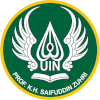Study of the spicy porridge tradition at the early Ramadhan in the Malay community
DOI:
https://doi.org/10.24090/ibda.v21i1.6552Keywords:
Islamic tradition, Malay community, spicy porridgeAbstract
Indonesia is a diverse country with numerous tribes and cultures, and the local culture greatly influences society, particularly in religious practices. The relationship between culture, local traditions, and Islam is vital for acceptance and influence within communities, as seen in the example of the spicy porridge tradition among the Malay community during Ramadan in North Sumatra. Several ingredients are used in making spicy porridge, including vegetables, tubers, nuts, and other ingredients. This study aims to explain the background of the spicy porridge tradition and the meaning of the spicy porridge tradition for the Malay community. The method used in this study is qualitative-descriptive research. The purpose of using a qualitative method is to emphasize that spicy porridge is Malay food served during Ramadan. It is because it is complicated and takes a long time to make it. In addition, the Malay communities’ habit of serving spicy porridge is only during Ramadan. Meanwhile, the benefits of spicy porridge itself are to warm and nourish the body because it consists of ingredients such as spices and vegetables. Additionally, it highlights the importance of the essence and authenticity of the dish, emphasizing the value of community interaction in its preparation.Downloads
References
Abdurrahman, D. (2007). Metodologi penelitian sejarah. Ar-Ruzz Media.
Aliyas, A. (2020). Tradisi masyarakat Islam Melayu Jambi: Perspektif Pierre Bordieau. Rihlah: Jurnal Sejarah dan Kebudayaan, 8(2), 134*144. https://doi.org/10.24252/rihlah.v8i2.15388 DOI: https://doi.org/10.24252/rihlah.v8i2.15388
Budiwanti, E. (2000). Islam Wetu Tuku Versus Waktu Lama. LKiS.
Buhori, B. (2017). Islam dan tradisi lokal di Nusantara (Telaah kritis terhadap tradisi Pelet Betteng pada masyarakat Madura dalam perspektif hukum Islam). Al Maslahah Jurnal Ilmu Syariah, 13(2), 229–246. https://doi.org/10.24260/almaslahah.v13i2.926 DOI: https://doi.org/10.24260/almaslahah.v13i2.926
Casmana, A. R., Dewantara, J. A., Timoera, D. A., Kusmawati, A. P., & Syafrudin, I. (2023). Global citizenship: Preparing the younger generation to possess proenvironment behavior, mutual assistance and tolerance awareness through school engagement. Globalisation, Societies and Education, 21(1), 15–32. https://doi.org/10.1080/14767724.2021.2013167 DOI: https://doi.org/10.1080/14767724.2021.2013167
Faris, S. (2014). Islam dan budaya lokal (Studi atas tradisi keislaman masyarakat Jawa). Thaqafiyyat: Jurnal Bahasa, Peradaban dan Informasi Islam, 15(1), 74–90. https://ejournal.uin-suka.ac.id/adab/thaqafiyyat/article/view/596/
Foster, G. M., & Anderson, B. G. (1986). Antropologi kesehatan. UI Press.
Jannah, A. Z. (2020). Bentuk dan makna pada penamaan selametan masyarakat
Jawa: Kajian linguistik antropologi. Dialektika: Jurnal Bahasa, Sastra, dan Pendidikan Bahasa dan Sastra Indonesia, 7(1), 76–88. https://doi.org/10.15408/dialektika.v7i1.13722 DOI: https://doi.org/10.15408/dialektika.v7i1.13722
Karim, A. (2017). Makna ritual kematian dalam tradisi Islam Jawa. Sabda: Jurnal Kajian Kebudayaan, 12(2), 161. https://doi.org/10.14710/sabda.12.2.161-171 DOI: https://doi.org/10.14710/sabda.12.2.161-171
Kowalczyk, O., Roszkowski, K., Montane, X., Pawliszak, W., Tylkowski, B., & Bajek, A. (2020). Religion and faith perception in a pandemic of COVID-19. Journal of Religion and Health, 59(6), 2671–2677. https://doi.org/10.1007/s10943-020-01088-3 DOI: https://doi.org/10.1007/s10943-020-01088-3
Kuntowijoyo. (2006). Budaya dan masyarakat. Tiara Wacana.
Lan, T. X., & Navera, G. S. (2022). The slanted beam: A critical discourse analysis of anti-Islam and anti-Muslim discourse in China. Discourse & Society, 33(1), 107–125. https://doi.org/10.1177/09579265211048704 DOI: https://doi.org/10.1177/09579265211048704
Lužný, D. (2021). Invented religions and the conceptualization of religion in a highly
secular society: The Jedi religion and the Church of Beer in the Czech context. European Journal of Cultural Studies, 24(5), 1160–1179. https://doi.org/10.1177/1367549420919876 DOI: https://doi.org/10.1177/1367549420919876
Mawardi, K. (2019). Tradisi Nyewu di komunitas Jamaah Mujahadah Sapu Jagad Dusun Jiwan, Desa Argomulyo, Kecamatan Cangkringan Kabupaten Sleman Daerah Istimewa Yogyakarta. Ibda`: Jurnal Kajian Islam dan Budaya, 17(1), 106–127. https://doi.org/10.24090/ibda.v17i1.2768 DOI: https://doi.org/10.24090/ibda.v17i1.2768
Muchtar, R. (2009). Harmonisasi agama dan budaya di Indonesia. Nusantara Lestari Ceriapratama
Muhaimin AG. (2001). Islam dalam bingkai budaya lokal: Potret dari Cirebon. Logos Wacana Ilmu.
Muniri, A. (2020). Tradisi Slametan: Yasinan manifestasi nilai sosial-keagamaan di Trenggalek. J-PIPS (Jurnal Pendidikan Ilmu Pengetahuan Sosial), 6(2), 71–78. https://doi.org/10.18860/jpips.v6i2.9050 DOI: https://doi.org/10.18860/jpips.v6i2.9050
Pramudita, K., & Rosnawati, R. (2019). Exploration of Javanese culture ethnomathematics based on geometry perspective. Journal of Physics: Conference Series, 1200(1), 012002. https://doi.org/10.1088/1742-6596/1200/1/012002 DOI: https://doi.org/10.1088/1742-6596/1200/1/012002
Ricklefs. (2012). Sejarah Asia Tenggara. Komunitas Bambu.
Roibin, R. (2015). Dialektika agama dan budaya dalam tradisi selamatan pernikahan adat Jawa di Ngajum, Malang. El-Harakah: Jurnal Budaya Islam, 15(1), 34. https://doi.org/10.18860/el.v15i1.2671 DOI: https://doi.org/10.18860/el.v15i1.2671
Saputri, I. N. (2017). Perkembangan Kubah Batu, Masjid Damaskus, perluasan
Masjid al-Haram dan Masjid Nabawi pada masa Khalifah Abdul Malik bin Marwan dan Walid bin Abdul Malik. Millati: Journal of Islamic Studies and Humanities, 2(2), 195–220. https://doi.org/10.18326/mlt.v2i2.195-220 DOI: https://doi.org/10.18326/mlt.v2i2.195-220
Setyawan, B. W., & Saddhono, K. (2017). Eret traditional ceremony as representation of spirit of mutual cooperation among coastal communities.Advanced Science Letters, 23(10), 9991–9992. https://doi.org/10.1166/asl.2017.10363 DOI: https://doi.org/10.1166/asl.2017.10363
Supriyadi, D. (2008). Sejarah peradaban Islam. Pustaka Setia.
Downloads
Published
How to Cite
Issue
Section
License
Copyright (c) 2023 M. Nasihudin Ali

This work is licensed under a Creative Commons Attribution-ShareAlike 4.0 International License.
Authors who publish with this journal agree to the following terms:
- Authors retain copyright and grant the journal right of first publication with the work simultaneously licensed under a Creative Commons Attribution-ShareAlike License a that allows others to share the work with an acknowledgement of the work's authorship and initial publication in this journal.
- Authors are able to enter into separate, additional contractual arrangements for the non-exclusive distribution of the journal's published version of the work (e.g., post it to an institutional repository or publish it in a book), with an acknowledgment of its initial publication in this journal.
- Authors are permitted and encouraged to post their work online (e.g., in institutional repositories or on their website) before and during the submission process, as it can lead to productive exchanges, as well as earlier and greater citation of published work (See The Effect of Open Access).

















